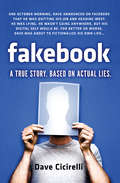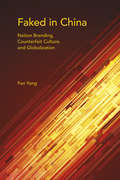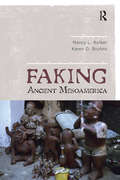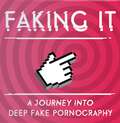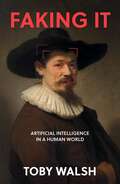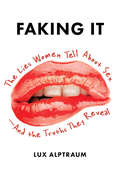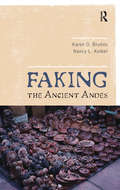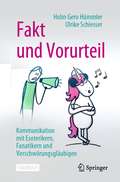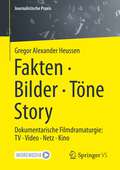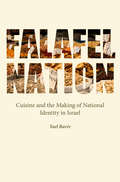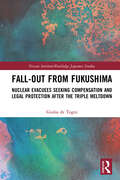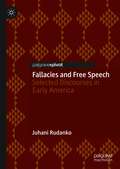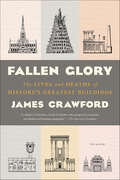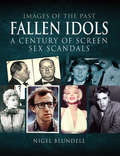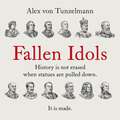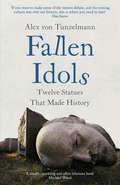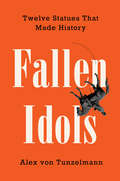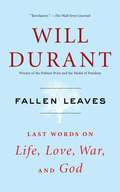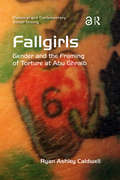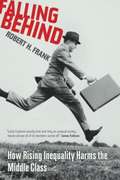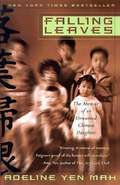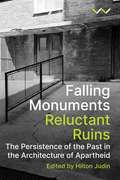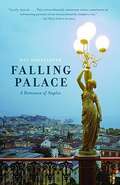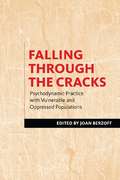- Table View
- List View
Fakebook
by Dave CicirelliThis hilarious, irreverent, and profoundly honest memoir explores our cultural obsession with social media and dares to ask: Who is the real "you" and what is the story you tell others? At age 26, Dave Cicirelli found himself at a crossroads. While his friends on Facebook appeared to have lives of nonstop accomplishments, his early adulthood felt disappointingly routine. So one October morning, Dave announced on Facebook that he was dropping everything and heading west. Many thought him brave--or crazy. No one guessed he was lying. "Fake Dave" set off on a wild adventure, toilet-papering an Amish horse and buggy, freight-hopping with a farmer's daughter, and being kidnapped by a religious cult. But the online prank quickly became a social experiment. People began connecting over his journey, and some were inspired to change their own lives. But as Fake Dave's popularity grew, the real Dave became increasingly isolated, struggling with the implications of his secret. Clever, funny, and surprisingly candid, FAKEBOOK is a true memoir of our digital age. It explores what the old ideas of reputation and relationships mean in our new world of constant connection and ultimately asks: How do you draw the line between your virtual self and who you really are? And can you discover yourself on a journey that never took place?
Faked in China
by Fan YangFaked in China is a critical account of the cultural challenge faced by China following its accession to the World Trade Organization in 2001. It traces the interactions between nation branding and counterfeit culture, two manifestations of the globalizing Intellectual Property Rights (IPR) regime that give rise to competing visions for the nation. Nation branding is a state-sanctioned policy, captured by the slogan "From Made in China to Created in China," which aims to transform China from a manufacturer of foreign goods into a nation that creates its own IPR-eligible brands. Counterfeit culture is the transnational making, selling, and buying of unauthorized products. This cultural dilemma of the postsocialist state demonstrates the unequal relations of power that persist in contemporary globalization.
Faking Ancient Mesoamerica
by Karen O Bruhns Nancy L KelkerCrystal skulls, imaginative codices, dubious Olmec heads and cute Colima dogs. Fakes and forgeries run rampant in the Mesoamerican art collections of international museums and private individuals. Authors Nancy Kelker and Karen Bruhns examine the phenomenon in this eye-opening volume. They discuss the most commonly forged classes and styles of artifacts, many of which were being duplicated as early as the 19th century. More important, they describe the system whereby these objects get made, purchased, authenticated, and placed in major museums as well as the complicity of forgers, dealers, curators, and collectors in this system. Unique to this volume are biographies of several of the forgers, who describe their craft and how they are able to effectively fool connoisseurs and specialists. An important, accessible introduction to pre-Columbian art fraud for archaeologists, art historians, and museum professionals alike. A parallel volume by the same authors discusses fakes in Andean archaeology.
Faking It: A journey into deep fake pornography
by Michael GrothausSeeing is believing, but what happens when you can't believe your own eyes? It's time to go down the rabbit hole...Imagine watching yourself on screen. Seeing your own face, but knowing it's not you. Imagine if someone you didn't know, or worse, someone you did know, could put your face anywhere, make it say or do anything. With deepfake technology, they can. And like most things on the internet, it was made for pornography. Whether you're a celebrity, a porn actor, an ex-girlfriend or just a next-door neighbour, it could happen to you.Journalist and author Michael Grothaus has spent years researching and writing about the dark side of the internet, from online trolls and pornography to sex-trafficking. This is his quest to pull back the curtain on deep fake pornography. Who's making it? Who's affected by it? Who's trying to stop it? And what happens next?(P)2022 Hodder & Stoughton Limited
Faking It: Artificial Intelligence in a Human World
by Toby Walsh‘Refreshingly clear-eyed … Faking It is an insightful and intelligent book that’s a must for those looking for facts about AI hype.’ – Books+Publishing‘AI will be as big a game-changer as the smart phone and the personal computer – or bigger! This book will help you navigate the revolution.’ – Dr Karl KruszelnickiArtificial intelligence is, as the name suggests, artificial and fundamentally different to human intelligence. Yet often the goal of AI is to fake human intelligence. This deceit has been there from the very beginning. We’ve been trying to fake it since Alan Turing answered the question ‘Can machines think?’ by proposing that machines pretend to be humans.Now we are starting to build AI that truly deceives us. Powerful AIs such as ChatGPT can convince us they are intelligent and blur the distinction between what is real and what is simulated. In reality, they lack true understanding, sentience and common sense. But this doesn’t mean they can’t change the world.Can AI systems ever be creative? Can they be moral? What can we do to ensure they are not harmful? In this fun and fascinating book, Professor Toby Walsh explores all the ways AI fakes it, and what this means for humanity – now and in the future.
Faking It: The Lies Women Tell about Sex--And the Truths They Reveal
by Lux AlptraumFrom Out of the Binders co-founder Lux Alptraum, a controversial look at women, sex, and lying--why myths about women's deceit persist, how they came to be, and ultimately why we must trust women When we talk about sex, we talk about women as mysterious, deceptive, and - above all - untrustworthy. Women lie about orgasms. Women lie about being virgins. Women lie about who got them pregnant, about whether they were raped, about how many people they've had sex with and what sort of experiences they've had - the list goes on and on. Over and over we're reminded that, on dates, in relationships, and especially in the bedroom, women just aren't telling the truth. But where does this assumption come from? Are women actually lying about sex, or does society just think we are? In Faking It, Lux Alptraum tackles the topic of seemingly dishonest women; investigating whether women actually lie, and what social situations might encourage deceptions both great and small. Using her experience as a sex educator and former CEO of Fleshbot (the foremost blog on sexuality), first-hand interviews with sexuality experts and everyday women, Alptraum raises important questions: are lying women all that common - or is the idea of the dishonest woman a symptom of male paranoia? Are women trying to please men, or just avoid their anger? And what affect does all this dishonesty - whether real or imagined - have on women's self-images, social status, and safety? Through it all, Alptraum posits that even if women are lying, we're doing it for very good reason--to protect ourselves ("My boyfriend will be here any minute," to a creep who won't go away, for one), and in situations where society has given us no other choice.
Faking the Ancient Andes
by Karen O Bruhns Nancy L KelkerNasca pots, Quimbaya figurines, Moche porn figures, stone shamans. Fakes and forgeries run rampant in the Andean art collections of international museums and private individuals. Authors Karen Bruhns and Nancy Kelker examine the phenomenon in this eye-opening volume. They discuss the most commonly forged classes and styles of artifacts, many of which were being duplicated as early as the 19th century. More important, they describe the system whereby these objects get made, purchased, authenticated, and placed in major museums as well as the complicity of forgers, dealers, curators, and collectors in this system. Unique to this volume are biographies of several of the forgers, who describe their craft and how they are able to effectively fool connoisseurs and specialists. This is an important accessible introduction to pre-Columbian art fraud for archaeologists, art historians, and museum professionals alike. A parallel volume by the same authors discusses fakes in Mesoamerican archaeology.
Fakt und Vorurteil: Kommunikation mit Esoterikern, Fanatikern und Verschwörungsgläubigen
by Holm Gero Hümmler Ulrike SchiesserBeim Kaffeetrinken mit der Familie wird Ihnen energetisiertes Wasser angeboten. Auf Twitter diskutieren Sie mit Impfgegnern. Die WhatsApp-Kitagruppe diskutiert Sternzeichen, die Apotheke verkauft Ihnen Globuli, die Nachbarin missioniert für ihren Guru und die Nachrichten beschäftigen sich schon wieder mit Demonstrationen von Rechtsextremen.Überall begegnen Ihnen Verschwörungsmythen, Aberglaube, Esoterik, Pseudowissenschaften und Co. und Sie möchten darauf reagieren – dabei möglichst sachlich bleiben, Ihren Standpunkt klarstellen, Fakten liefern, aber auch nicht unnötig provozieren oder überladen. Außerdem möchten Sie Ihr Gegenüber nicht verletzen, aber zum Umdenken anregen. Doch wie gelingt das?Wenn Sie sich diese Frage stellen, lesen Sie „Fakt und Vorurteil“. Verstehen Sie, warum wir von Emotionen gesteuert sind und die meisten Informationen an uns abprallen. Lesen Sie Erfahrungen und Tipps aus Interviews mit professionellen (Wissenschafts-)Kommunikatoren. Verfolgen Sie dann unterschiedliche Personen durch ihre eigenen Umdenkprozesse: Was überzeugt einen Alternativmediziner davon, nichtevidenzbasierte Medizin hinter sich zu lassen? Was war ausschlaggebend für eine ehemalige Impfgegnerin, ihre Kinder doch impfen zu lassen? Was hilft Mitgliedern von vereinnahmenden Organisationen beim Ausstieg? Was bewegt ein gefeiertes Medium, sich aus der Esoterik zu lösen? Dieses Buch richtet sich an alle, die sich um Personen mit irrationalen Weltsichten sorgen oder nicht wissen, wie sie mit ihnen kommunizieren sollen – sei es in der Familie, im Freundeskreis, anonym im Internet oder bei der Arbeit. Die Autoren geben konkrete Tipps zu Diskussionen und Situationen und helfen auch dabei zu entscheiden, wann es wichtig ist sich zu engagieren und wann man sich lieber zurückzieht.
Fakten statt Fakes: Wie Medien und Organisationen wieder glaubwürdig werden
by Julia Frohne Alexander GüttlerFake News, PR-Skandal, Mainstream-Presse – diese Schlagworte kennzeichnen vor allem eines: den Vertrauensverlust der Öffentlichkeit in die Berichterstattung von Medien und Unternehmen. In einem nahezu unentwirrbaren Kommunikationsdschungel aus Medien, Internetportalen und sozialen Plattformen wird es nicht nur für Laien immer schwieriger, verlässliche und unseriöse Kommunikation voneinander zu unterscheiden.So steigt die Anzahl derer, die professioneller Kommunikation mit Misstrauen begegnen und in ihr vor allem Einflussnahme oder gar Manipulation sehen. Aus den Augen gerät dabei oft, dass Deutschland über eines der freiheitlichsten und vielfältigsten Mediensysteme der Welt verfügt.Das Buch diskutiert die Grenzen zwischen Manipulation und Kommunikation on- wie offline und zeigt, wie man schlampige und seriöse Meinungsmacher unterscheidet, welche Rolle Fakten spielen und wie Medien und Unternehmen dazu beitragen können, dass Glaubwürdigkeit in der medialen Debatte wieder einen Stellenwert bekommt.
Fakten · Bilder · Töne · Story: Dokumentarische Filmdramaturgie: TV · Video · Netz · Kino (Journalistische Praxis)
by Gregor Alexander HeussenDokumentarische Filme aller Genres in TV, Kino und Netz entfalten ihre informative Kraft erst dann, wenn sie dramaturgisch als Erzählungen strukturiert sind, nicht als Aufzählungen. Sie müssen die Emotionen des Publikums wecken, damit die filmische Information verstanden werden kann. Wirksame dokumentarische Filmgestaltung ist begründet in der Art, wie Menschen hinschauen und hinhören. Ihre Wahrnehmungen werden zu Vorstellungen; diese prägen die Information. Dadurch verändern sich viele überkommene Regeln für Dokumentarische Filme. Neue Ideen werden möglich. Werkzeuge dafür sind der Erzählsatz, die Roten Fäden, die Drama-Elementarmuster, das konzentrierte Zusammenspiel der sechs filmischen Erzähler, Emotionsziel und Argumentziel und die für Erzählungen charakteristische Polaritätslogik. Anders als fiktionale Filme müssen Dokumentarische Filme durch ihre erzählerische Struktur und filmische Gestaltung einen nachprüfbaren Bezug zur Lebensrealität des Publikums schaffen. Spielfilme hingegen können in ihrem jeweils definierten Erzählkosmos plausibel und authentisch sein. Im Dokumentarischen lassen sich auch Werkzeuge und Muster der Fiktionalen Dramaturgie nutzen, aber mit anderer Absicht und Wirkung: sie müssen die Lebensrealität treffen. Das Buch von Gregor Alexander Heussen zeigt Dokumentarische Dramaturgie praktisch; und begründet sie mit Erkenntnissen der Kognitionswissenschaft. Redakteure* und Film-Auftraggeber* finden Werkzeuge und Denkwege für Planung, und Filmabnahme. Autoren* erfahren die Kraft der dramaturgischen Recherche und entdecken neue Gestaltungsmöglichkeiten bei Dreh und Montage. Das Buch ist ein Muss für alle, die sich für dokumentarischen Film in TV, Kino, Netz und Unternehmen interessieren. Mit dem Buch sind 29 runterladbare, sofort nutzbare Drama-Werkzeuge verlinkt.
Falafel Nation: Cuisine and the Making of National Identity in Israel (Studies of Jews in Society)
by Yael RavivWhen people discuss food in Israel, their debates ask politically charged questions: Who has the right to falafel? Whose hummus is better? But Yael Raviv’s Falafel Nation moves beyond the simply territorial to divulge the role food plays in the Jewish nation. She ponders the power struggles, moral dilemmas, and religious and ideological affiliations of the different ethnic groups that make up the “Jewish State” and how they relate to the gastronomy of the region. How do we interpret the recent upsurge in the Israeli culinary scene—the transition from ideological asceticism to the current deluge of fine restaurants, gourmet stores, and related publications and media? <p><p> Focusing on the period between the 1905 immigration wave and the Six-Day War in 1967, Raviv explores foodways from the field, factory, market, and kitchen to the table. She incorporates the role of women, ethnic groups, and different generations into the story of Zionism and offers new assertions from a secular-foodie perspective on the relationship between Jewish religion and Jewish nationalism. A study of the changes in food practices and in attitudes toward food and cooking, Falafel Nation explains how the change in the relationship between Israelis and their food mirrors the search for a definition of modern Jewish nationalism.
Fall-out from Fukushima: Nuclear Evacuees Seeking Compensation and Legal Protection After the Triple Meltdown (Nissan Institute/Routledge Japanese Studies)
by Giulia de TogniThis book shows how the Fukushima plaintiffs have challenged narratives of safety and risk containment produced by TEPCO and the Japanese government through offering new empirical data on risk perceptions and life choices of some nuclear evacuees. Considering the Fukushima evacuees’ disappearance from public discourse in Japan, the book engages with theoretical writings on risk, neoliberal governmentality and citizen science. Chapters draw on a wide range of anthropologically-related methodologies including socio-linguistics, participant observation, and qualitative interviews. Themes of self-governance, resistance, gender, kinship, class and social change surface throughout, setting the Fukushima experience in a broad historical, social, and comparative context. This is the first ethnographic account of the Fukushima litigation and the first extensive qualitative study documenting the worldviews and living conditions of nuclear evacuees who moved outside Fukushima Prefecture, with a particular focus on underrepresented groups (single mothers, elderly and disabled evacuees). The history of industrial disasters and the role of citizens in shaping environmental policy in Japan is also evaluated. Fall-out from Fukushima sets out to be a manifesto for understanding and supporting post-nuclear disaster societies, and will appeal to students and scholars of social, legal, and linguistic anthropology, science and technology studies, as well as Japanese studies.
Fallacies and Free Speech: Selected Discourses in Early America
by Juhani RudankoThis book offers a new perspective on selected discourses and texts bearing on the evolution of a distinctively American tradition of free speech. The author’s approach privileges fallacy theory, especially the fallacy of ad socordiam, in a key Congressional debate in 1789 and other forms of verbal manipulation in newspaper editorials during the War of 1812. He argues that in order to understand James Madison’s role in the evolution of a broad conception of freedom of speech, it is imperative to examine the nature of the verbal attacks targeted at him. These attacks are documented, analyzed with the concept of aggravated impoliteness, and used to demonstrate that it was Madison’s toleration of criticism, even in wartime, that provided a foundation for a broad conception of freedom of speech. This book will be of interest to both scholars and lay readers with an interest in the application of discourse analysis and historical pragmatics to political debates, argumentation theory and fallacy theory, and the evolution of the concept of freedom of speech in the early years of the United States.
Fallen Glory: The Lives and Deaths of History's Greatest Buildings
by James Crawford“A narrative that spans seven millennia, five continents and even reaches into cyberspace. . . . I savored each page.” —Henry Petroski, Wall Street JournalIn Fallen Glory, James Crawford uncovers the biographies of some of the world’s most fascinating lost and ruined buildings, from the dawn of civilization to the cyber era. The lives of these iconic structures are packed with drama and intrigue, featuring war and religion, politics and art, love and betrayal, catastrophe and hope. They provide the stage for a startling array of characters, including Gilgamesh, the Cretan Minotaur, Agamemnon, Nefertiti, Genghis Khan, Henry VIII, Catherine the Great, Adolf Hitler, and even Bruce Springsteen.The twenty-one structures Crawford focuses on include The Tower of Babel, The Temple of Jerusalem, The Library of Alexandria, The Bastille, Kowloon Walled City, the Berlin Wall, and the Twin Towers of the World Trade Center. Ranging from the deserts of Iraq, the banks of the Nile and the cloud forests of Peru, to the great cities of Jerusalem, Istanbul, Paris, Rome, London and New York, Fallen Glory is a unique guide to a world of vanished architecture. And, by picking through the fragments of our past, it asks what history’s scattered ruins can tell us about our own future.“Witty and memorable . . . moving as well as myth-busting.” —Times Literary Supplement (UK)“[An] elegant, charged book . . . A well-written prize for students of history, archaeology, and urban planning.” —Kirkus Reviews, starred review“Astute, entertaining, and affecting.” —Booklist“A lovely, wise book.” —Alexander McCall Smith, New Statesman (UK)“A cabinet of curiosities, a book of wonders with unexpected excursions and jubilant and haunting marginalia.” —Spectator (UK)
Fallen Idols: A Century of Screen Sex Scandals (Images of the Past)
by Nigel BlundellIts a scandal! How often we use that phrase and what a catalogue of sins it covers. Thats what this book is all about. It is literally a catalogue of sins committed by some of the most celebrated names on the planet.Within these covers are startling stories of scandals during a century when screen idols seemed to vie with each other in outraging public decency. It was an age when fan fever was at its height and an endless supply of shocking revelations emerged to fuel the frenzy.Because of the perpetrators superstar status, the shame of exposure was often heightened, not only wrecking reputations but often harming careers and, at least, ensuring very public humiliation.The lessons learned from these cases of celebrity scandal (though often, it seems, not by the celebrities themselves) is that the bigger the star, the harder the fall and that deceit and intrigue so often turn hard-won fame into instant infamy.
Fallen Idols: History is not erased when statues are pulled down. It is made.
by Alex von Tunzelmann'Alex von Tunzelmann is one of the most gifted historians writing today. Brilliant and trenchant, witty and wise, Fallen Idols is a book you will adore, devour, and talk about to everyone you know. Hesitate no longer; buy this book.' Suzannah Lipscomb, author, award-winning historian and broadcaster'Like all the best historians von Tunzelmann uses the past to explain what the hell is going on today. She does so with a flair, her signature mix of scholarship and succinctness that is so compelling. If you want to make sense of the statues debate, and the coming culture war over our history, this is where you need to start.' Dan Snow'A timely, sparkling and often hilarious book.' Michael Wood A hugely entertaining and informative narrative on one of the key arguments raging across the globe - how does one honestly celebrate a country's past without knocking down celebrated heroes.In 2020, statues across the world were pulled down in an extraordinary wave of global iconoclasm. From the United States and the United Kingdom to Canada, South Africa, the Caribbean, India, Bangladesh, and New Zealand, Black Lives Matter protests defaced and hauled down statues of slaveholders, Confederates, and imperialists. Edward Colston was hurled into the harbour in Bristol, England. Robert E. Lee was covered in graffiti in Richmond, Virginia. Christopher Columbus was toppled in Minnesota, beheaded in Massachusetts, and thrown into a lake in Virginia. King Leopold II of the Belgians was set on fire in Antwerp and doused in red paint in Ghent. Winston Churchill was daubed with the word 'racist' in London.Statues are one of the most visible - and controversial - forms of historical storytelling. The stories we tell about history are vital to how we, as societies, understand our past and create our future. So whose stories do we tell? Who or what defines us? What if we don't all agree? How is history made, and why?FALLEN IDOLS looks at twelve statues in modern history. It looks at why they were put up; the stories they were supposed to tell; why those stories were challenged; and how they came down.History is not erased when statues are pulled down. If anything, it is made.(P)2021 Headline Publishing Group Limited
Fallen Idols: Twelve Statues That Made History
by Alex Von Tunzelmann'Alex von Tunzelmann is one of the most gifted historians writing today. Brilliant and trenchant, witty and wise, Fallen Idols is a book you will adore, devour, and talk about to everyone you know. Hesitate no longer; buy this book.' Suzannah Lipscomb, author, award-winning historian and broadcaster'Like all the best historians von Tunzelmann uses the past to explain what the hell is going on today. She does so with a flair, her signature mix of scholarship and succinctness that is so compelling. If you want to make sense of the statues debate, and the coming culture war over our history, this is where you need to start.' Dan Snow'A timely, sparkling and often hilarious book.' Michael Wood In 2020, statues across the world were pulled down in an extraordinary wave of global iconoclasm. From the United States and the United Kingdom to Canada, South Africa, the Caribbean, India, Bangladesh, and New Zealand, Black Lives Matter protests defaced and hauled down statues of slaveholders, Confederates, and imperialists. Edward Colston was hurled into the harbour in Bristol, England. Robert E. Lee was covered in graffiti in Richmond, Virginia. Christopher Columbus was toppled in Minnesota, beheaded in Massachusetts, and thrown into a lake in Virginia. King Leopold II of the Belgians was set on fire in Antwerp and doused in red paint in Ghent. Winston Churchill was daubed with the word 'racist' in London.Statues are one of the most visible - and controversial - forms of historical storytelling. The stories we tell about history are vital to how we, as societies, understand our past and create our future. So whose stories do we tell? Who or what defines us? What if we don't all agree? How is history made, and why?FALLEN IDOLS looks at twelve statues in modern history. It looks at why they were put up; the stories they were supposed to tell; why those stories were challenged; and how they came down.History is not erased when statues are pulled down. If anything, it is made.
Fallen Idols: Twelve Statues That Made History
by Alex von TunzelmannAn Economist Best Book of the YearIn this timely and lively look at the act of toppling monuments, the popular historian and author of Blood and Sand explores the vital question of how a society remembers—and confronts—the past.In 2020, history came tumbling down. From the US and the UK to Belgium, New Zealand, and Bangladesh, Black Lives Matter protesters defaced, and in some cases, hauled down statues of Confederate icons, slaveholders, and imperialists. General Robert E. Lee, head of the Confederate Army, was covered in graffiti in Richmond, Virginia. Edward Colston, a member of Parliament and slave trader, was knocked off his plinth in Bristol, England, and hurled into the harbor. Statues of Christopher Columbus were toppled in Minnesota, burned and thrown into a lake in Virginia, and beheaded in Massachusetts. Belgian King Leopold II was set on fire in Antwerp and doused in red paint in Ghent. Winston Churchill’s monument in London was daubed with the word “racist.” As these iconic effigies fell, the backlash was swift and intense.But as the past three hundred years have shown, history is not erased when statues are removed. If anything, Alex von Tunzelmann reminds us, it is made.Exploring the rise and fall of twelve famous, yet now controversial statues, she takes us on a fascinating global historical tour around North America, Western and Eastern Europe, Latin America and Asia, filled with larger than life characters and dramatic stories. Von Tunzelmann reveals that statues are not historical records but political statements and distinguishes between statuary—the representation of “virtuous” individuals, usually “Great Men”—and other forms of sculpture, public art, and memorialization. Nobody wants to get rid of all memorials. But Fallen Idols asks: have statues had their day?
Fallen Leaves: Last Words on Life, Love, War, and God
by Will DurantThe final and most personal work from Pulitzer Prize-winning author and historian Will Durant--discovered thirty-two years after his death--is a message of insight for everyone who has sought meaning in life or the council of a wise friend in navigating life's journey.From 1968 to 1978, Will Durant made four public allusions to the existence of Fallen Leaves. One, in 1975, hinted at its contents: "a not very serious book that answers the questions of what I think about government, life, death, and God." And in 1975: "I propose...to answer all the important questions, simply, fairly, and imperfectly." Even into his nineties, he worked on the book daily, writing it out on legal notepads. On his death in 1981, no one, not even the Durant heirs, knew if he had completed it, or even if it still existed. Thirty-two years later, in a granddaughter's attic trunk, the manuscript was discovered. Fallen Leaves is Will Durant's most personal book. It is precisely as he described: twenty-two short chapters on everything from youth and old age, religion and morals, to sex, war, politics, and art. The culmination of Will Durant's sixty-plus years spent researching the philosophies, religions, arts, sciences, and civilizations from across the world, Fallen Leaves is the distilled wisdom of a gifted scholar with a renowned talent for rendering the insights of the past accessible. In its preface Durant mentions that over the course of his career he received letters from "curious readers who have challenged me to speak my mind on the timeless questions of human life and fate." With Fallen Leaves he accepted their challenge. It contains strong opinions, elegant prose, and deep insights into the human condition as only Will Durant could provide, as well as his revealing conclusions about the perennial problems and greatest joys we face as a species.
Fallgirls: Gender and the Framing of Torture at Abu Ghraib (Classical and Contemporary Social Theory)
by Ryan Ashley CaldwellFallgirls provides an analysis of the abuses that took place at Abu Ghraib in terms of social theory, gender and power, based on first-hand participant-observations of the courts-martials of Lynndie England and Sabrina Harman. This book examines the trials themselves, including interactions with soldiers and defense teams, documents pertaining to the courts-martials, US government reports and photographs from Abu Ghraib, in order to challenge the view that the abuses were carried out at the hands of a few rogue soldiers. With a keen focus on gender and sexuality as prominent aspects of the abuses themselves, as well as the ways in which they were portrayed and tried, Fallgirls engages with modern feminist thought and contemporary social theory in order to analyse the manner in which the abuses were framed, whilst also exploring the various lived realities of Abu Ghraib by both prisoners and soldiers alike. Providing a unique perspective and a thorough theoretical examination of the events, their framing and depiction, this book will be of interest to sociologists, feminists, and social and political theorists concerned with cultural studies, political communication and gender and sexuality.
Falling Behind: How Rising Inequality Harms the Middle Class
by Robert H. Frank[Back Cover] Although middle-income families don't earn much more than they did several decades ago, they are buying bigger cars, houses, and appliances. To pay for them, they spend more than they earn and carry record levels of debt. In a book exploring the very meaning of happiness and prosperity in America today, Robert Frank explains how increased concentrations of income and wealth at the top of the economic pyramid have set off "expenditure cascades" that raise the cost of achieving many basic goals for the middle class. Drawing from up-to-date economic data and everyday examples, Frank compels us to rethink how and why we live our economic lives the way we do.
Falling Leaves: The True Story of an Unwanted Chinese Daughter
by Adeline Yen Mahfrom the book jacket "I read for two nights, sleepless, my Heart pierced by Adeline Yen Mah's account of her terrible childhood. Falling Leaves is a potent psychological drama pitting a stubborn little girl against the most merciless of adversaries and rivals: her own family. I am still haunted by Mah's memoir. Amy Tan, author of The Joy Luck. Club Born in 1957 in a port city a thousand miles north of Shanghai, Adeline Yen Ma was the youngest child of an affluent Chinese family who enjoyed rare privileges during a time of political and cultural upheaval. But wealth and position could not shield Adeline from a childhood of appalling emotional abuse at the hands of a cruel and manipulative Eurasian stepmother. Determined to survive through her enduring faith in family unity, Adeline struggled for independence as she moved from Hong Kong to England and eventually to the United States to become a physician and writer. A compelling, painful, and ultimately triumphant story of a girl's journey into adulthood, Adeline's story is a testament to the most basic of human needs acceptance, love, and understanding. Scanners note: The Chinese characters found in the printed copy of this book could not be meaningfully represented in the electronic text.
Falling Monuments, Reluctant Ruins: The persistence of the past in the architecture of apartheid
by Hilton JudinThis edited collection looks at ruins and vacant buildings as part of South Africa’s oppressive history of colonialism and apartheid and ways in which the past persists into the presentFalling Monuments, Reluctant Ruins: The Persistence of the Past in the Architecture of Apartheid interrogates how, in the era of decolonization, post-apartheid South Africa reckons with its past in order to shape its future. Architects, historians, artists, social anthropologists and urban planners seek answers in this book to complex and unsettling questions around heritage, ruins and remembrance. What do we do with hollow memorials and political architectural remnants? Which should remain, which forgotten, and which dismantled? Are these vacant buildings, cemeteries, statues, and derelict grounds able to serve as inspiration in the fight against enduring racism and social neglect? Should they become exemplary as spaces for restitution and justice? The contributors examine the influence of public memory, planning and activism on such anguished places of oppression, resistance and defiance. Their focus on visible markers in the landscape to interrogate our past will make readers reconsider these spaces, looking at their landscape and history anew. Through a series of 14 empirically grounded chapters and 48 images, the contributors seek to understand how architecture contests or subverts these persistent conditions in order to promote social justice, land reclamation and urban rehabilitation. The decades following the dismantling of apartheid are surveyed in light of contemporary heritage projects, where building ruins and abandoned spaces are challenged and renegotiated across the country to become sites of protest, inspiration and anger. This ground-breaking collection is an important resource for professionals, academics and activists working in South Africa today.
Falling Palace: A Romance of Naples
by Dan HofstadterA portrait of the sun-drenched volcanic city from an American who has lost his heart to the place and to a beguiling Neapolitan woman. InFalling PalaceDan Hofstadter brilliantly reveals Naples, from the dilapidated architectural beauty to the irrepressible theater of everyday life. We witness the centuries-old festivals that regularly crowd the city’s jumbled streets, and eavesdrop on conversations that continue deep into the night. We browse the countless curio shops where treasures mingle with kitsch, and meet the locals he befriends. In and out of these encounters slips Benedetta, the object of the author’s affections, at once inviting and unfathomable. Weaving the tale of an elusive love together with a vivid portrayal of a legendary metropolis, this is a startling evocation of a magical place.
Falling Through the Cracks: Psychodynamic Practice with Vulnerable and Oppressed Populations
by Joan BerzoffPsychodynamic theory and practice are often misunderstood as appropriate only for the worried well or for those whose problems are minimal or routine. Nothing could be further from the truth. This book shows how psychodynamically informed, clinically based social care is essential to working with individuals whose problems are both psychological and social. Each chapter addresses populations struggling with structural inequities, such as racism, classism, and discrimination based on immigrant status, language differences, disability, and sexual orientation. The authors explain how to provide psychodynamically informed assessment and practice when working with those suffering from mental illness, addiction, homelessness, and cognitive, visual, or auditory impairments, as well as people in prisons, in orphanages, and on child welfare. The volume supports the idea that becoming aware of ourselves helps us understand ourselves: a key approach for helping clients contain and name their feelings, deal with desire and conflict, achieve self-regulation and self-esteem, and alter attachment styles toward greater agency and empowerment. Yet autonomy and empowerment are not birthrights; they are capacities that must be fostered under optimal clinical conditions.This collection uses concepts derived from drive theory, ego psychology, object relations, trauma theory, attachment theory, self psychology, relational theories, and intersubjectivity in clinical work with vulnerable and oppressed populations. Contributors are experienced practitioners whose work with vulnerable populations has enabled them to elicit and find common humanity with their clients. The authors consistently convey respect for the considerable strength and resilience of the populations with whom they work. Emphasizing both the inner and social structural lives of client and clinician and their interacting social identities, this anthology uniquely realizes the complexity of clinical practice with diverse populations.
